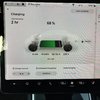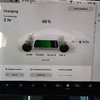Has anyone tried stopping the charge at the charge point and then restarting it a short time later, in order to kick-start the car into charging at the full rate?
For me, that's something fairly easy to do, as I already have a timed charge option on the charge point (that I can't normally use because of the other bug in Tesla's software that stops this working...).
The way I get around the bugs/non-compliance in Tesla's charge control system at the moment is to not use the charge point to control charging (because it just won't start to charge at all if the car is sleeping) and instead use the scheduled charge start option in the car set to start charging at 00:00, with the charge point set to "always on". As long as I never need more than about 65% charge this usually works OK, with the charge stopping around the 07:00 end of the off-peak period (we're on E7). However, this relies on the car charging at full rate all the time, if it reduces to 16 A, as it did soon after starting to charge last night, then the car will carry on charging way past the end of the cheap rate period, and leave me with a part-charged car (real nuisance when I'm on standby for a long trip at short notice).
If turning the charge point off and then on again works to kick-start the car into charging properly, then, as a real bodge of a work around, I could adjust the charge point "power available" period, so that it's always on between, say, late afternoon to maybe 00:15 when I'm most likely to plug the car in, then turn off for maybe 30 seconds at 00:15, and back on again (as a way to mitigate the half current problem), and then have the charge point power turn off again at 07:00, to mitigate the risk of charging running on into the peak rate period.
This is far from ideal, as it means having to set the car for a scheduled charge starting at 00:00, and also remembering to not plug it in until the charge point is already timed to be on, as when you set a scheduled charge time start the car needs to turn the charge point on immediately for a few minutes, rather than wait for the scheduled time, for reasons that aren't at all clear.
Just read through the list of updates in the software update from last night. I'd happily forego all of them if Tesla would just make charging work properly and be compliant with the standard and the statement in the owner's manual.
For me, that's something fairly easy to do, as I already have a timed charge option on the charge point (that I can't normally use because of the other bug in Tesla's software that stops this working...).
The way I get around the bugs/non-compliance in Tesla's charge control system at the moment is to not use the charge point to control charging (because it just won't start to charge at all if the car is sleeping) and instead use the scheduled charge start option in the car set to start charging at 00:00, with the charge point set to "always on". As long as I never need more than about 65% charge this usually works OK, with the charge stopping around the 07:00 end of the off-peak period (we're on E7). However, this relies on the car charging at full rate all the time, if it reduces to 16 A, as it did soon after starting to charge last night, then the car will carry on charging way past the end of the cheap rate period, and leave me with a part-charged car (real nuisance when I'm on standby for a long trip at short notice).
If turning the charge point off and then on again works to kick-start the car into charging properly, then, as a real bodge of a work around, I could adjust the charge point "power available" period, so that it's always on between, say, late afternoon to maybe 00:15 when I'm most likely to plug the car in, then turn off for maybe 30 seconds at 00:15, and back on again (as a way to mitigate the half current problem), and then have the charge point power turn off again at 07:00, to mitigate the risk of charging running on into the peak rate period.
This is far from ideal, as it means having to set the car for a scheduled charge starting at 00:00, and also remembering to not plug it in until the charge point is already timed to be on, as when you set a scheduled charge time start the car needs to turn the charge point on immediately for a few minutes, rather than wait for the scheduled time, for reasons that aren't at all clear.
Just read through the list of updates in the software update from last night. I'd happily forego all of them if Tesla would just make charging work properly and be compliant with the standard and the statement in the owner's manual.




